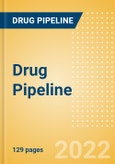Schizophrenia is a heterogeneous behavioral and cognitive syndrome involving chronic or recurrent psychosis. The disorder is characterized by several symptom domains including positive symptoms (such as hallucinations or delusions and disorganized speech), negative symptoms (such as a flat affect and poverty of speech), and cognitive deficits (including impaired attention, memory, and executive functions). As a result, schizophrenic patients commonly experience impairments in social and occupational functioning. The management of schizophrenia is challenging due to its clinical and genetic heterogeneity, which also complicates the elucidation of etiological and pathophysiological factors.
The schizophrenia market in the 7MM was valued at $9.0B in the 2021 baseline year. The publisher anticipates that over the 10-year forecast period, the market is projected to grow at a Compound Annual Growth Rate (CAGR) of 3.7%, reaching $13.0B by 2031.
The major driver for this growth will be the launch of 11 new pipeline products, each of which will have a higher annual cost of therapy (ACOT) when compared with the cost of the most commonly used antipsychotic treatments, which are highly genericized.
The schizophrenia market in the 7MM was valued at $9.0B in the 2021 baseline year. The publisher anticipates that over the 10-year forecast period, the market is projected to grow at a Compound Annual Growth Rate (CAGR) of 3.7%, reaching $13.0B by 2031.
The major driver for this growth will be the launch of 11 new pipeline products, each of which will have a higher annual cost of therapy (ACOT) when compared with the cost of the most commonly used antipsychotic treatments, which are highly genericized.
Key Highlights
- There is an increase in the diagnosed prevalent cases of schizophrenia by 2.6% in the 7MM combined over the forecast period
- The current schizophrenia treatment landscape includes many established atypical antipsychotic products that can help manage the positive symptoms of the disorder, such as hallucinations, delusions, and disorganized speech
- The schizophrenia market will exhibit moderate growth between 2021 and 2031, driven by the entry of 11 pipeline agents
- The potential for novel pharmacological therapies specifically indicated for cognitive impairment associated with schizophrenia (CIAS) and the negative symptoms of schizophrenia, two major unmet needs in the market, could provide new options for patients
- The prospect of four novel adjunctive therapies will be welcomed for patients who have a partial response to marketed antipsychotics. Rather than compete with existing therapies, adjunctive therapies will be prescribed in combination with generic antipsychotics
- What are the key schizophrenia treatments available in 2021?
- When will the late stage pipeline products launch, and how will they affect drug sales and the overall schizophrenia market in the 7MM?
- Which unmet needs will remain unaddressed in the forecast period and what opportunities remain for pharmaceutical companies?
Scope
- Overview of schizophrenia, including epidemiology, symptoms, diagnosis, and disease management
- Annualized schizophrenia therapeutics market revenue, cost of therapy per patient, and treatment usage patterns forecast from 2021 to 2031
- Key topics covered include strategic competitor assessment, market characterization, unmet needs, clinical trial mapping, and implications of these factors for the schizophrenia therapeutics market
- Pipeline analysis: comprehensive data assessing emerging trends and mechanisms of action under development for schizophrenia treatment. The most promising candidates in Phase III and Phase IIb development are profiled
- Analysis of the current and future market competition in the global schizophrenia therapeutics market. Insightful review of the key industry drivers, restraints and challenges. Each trend is independently researched to provide qualitative analysis of its implications
Reasons to Buy
The report will enable you to -- Develop and design your in-licensing and out-licensing strategies through a review of pipeline products and technologies, and by identifying the companies with the most robust pipeline
- Develop business strategies by understanding the trends shaping and driving the global schizophrenia therapeutics market
- Drive revenues by understanding the key trends, innovative products and technologies, market segments, and companies likely to impact the global schizophrenia therapeutics market in the future
- Formulate effective sales and marketing strategies by understanding the competitive landscape and by analyzing the performance of various competitors
- Identify emerging players with potentially strong product portfolios and create effective counter-strategies to gain a competitive advantage
- Organize your sales and marketing efforts by identifying the market categories and segments that present maximum opportunities for consolidations, investments and strategic partnerships
Table of Contents
1 Schizophrenia: Executive Summary
2 Introduction
3 Disease Overview
4 Epidemiology
5 Disease Management
6 Competitive Assessment
7 Unmet Needs and Opportunity Assessment
8 R&D Strategies
9 Pipeline Assessment
10 Pipeline Valuation Analysis
11 Current and Future Players
List of Tables
List of Figures
Companies Mentioned (Partial List)
A selection of companies mentioned in this report includes, but is not limited to:
- Acadia Pharmaceuticals
- BioXcel Therapeutics
- Boehringer Ingelheim
- Eli Lilly
- Gedeon Richter
- Intra-Cellular Therapies
- Johnson & Johnson
- Karuna Therapeutics
- Lundbeck
- Luye Pharma
- MedinCell
- Minerva Neurosciences
- Neurocrine Biosciences
- Novartis
- Otsuka
- Reviva Pharmaceuticals
- Sunovion Pharmaceuticals
- Teva








